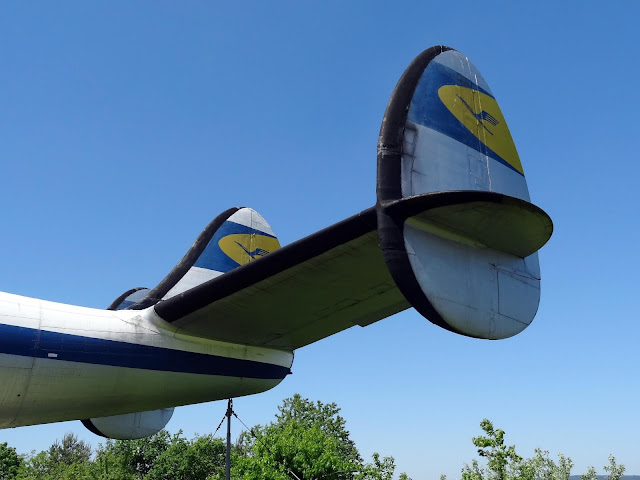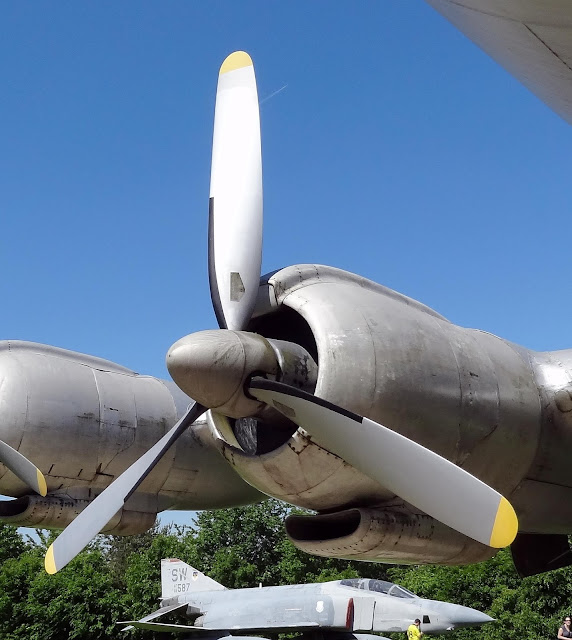Subject: Lockheed L1049G Super Constelation
Location: Flugausstellung Peter Junior, Germany 2012
Comments:The Lockheed L-1049 Super Constellation is an American aircraft, a member of the Lockheed Constellation aircraft line. The L-1049 was Lockheed's response to the successful Douglas DC-6 airliner, first flying in 1950. The aircraft was also produced for both the United States Navy and Air Force as transport and AWACS aircraft.When,in 1953, R-3350 Turbo-compounds were made available for civil use, Lockheed incorporated them into the L-1049C, which first flew on February 17 of that year. The R-3350-972-TC18DA-1 turbo-compound engines on the L-1049C had a new turbine system, the Power Recovery Turbines (PRT). Each engine's exhaust gas flowed through three turbines, increasing power by 550 hp (410 kW). One drawback of the PRT was the visible flame from the exhaust pipes; this was resolved by placing armor plating 2 in (5.08 cm) thick under the stack. The L-1049C had a higher cruising speed and climb rate. Although still lacking the range of the DC-6B, the L-1049C was now identical in performance to the Douglas and could carry a larger payload. The wings of the new model were strengthened, cabin soundproofing was increased, and the landing gear retraction system was improved. A new series of interior layouts was offered for the new model; "Siesta" (47 Passengers with increased luxury), "Intercontinental" (54 - 60 Passengers) and "Inter-urban" (105 Passengers). Each of these new layouts included reading lights at each seat. 48 L-1049Cs were built, being used by Eastern, TWA, Air France, KLM, Trans-Canada Air Lines, QANTAS, Air India, Pakistan International Airlines, Avianca, Iberia, Línea Aeropostal Venezolana and Cubana de Aviación.A freighter version, the L-1049D, first flew in August 1954. It had two cargo doors on the left side and a reinforced magnesium floor as used on the R7V-1 military variant of the L-1049B. The L-1049D could carry a 36,916 lb (16,745 kg) payload and had a volume of 5,579 ft³ (158 m³). At the time of its first flight, the L-1049D was the largest civil cargo aircraft. In the end four were produced, all delivered to Seaboard & Western Airlines. Two of the four L-1049D aircraft were later converted to L-1049H standards.The L-1049E was more successful; 28 were delivered to eight airlines. Similar to the L-1049C, the L-1049E was able to carry the same load as the L-1049D. The L-1049C and L-1049E could not usually fly Europe to New York nonstop against the wind. Lockheed thought of fitting a new variant based on the L-1049E with more powerful engines, but the project was cancelled. A different variant surfaced: using the L-1049C as a base, R-3350-972-TC18DA-3 turbo-compound engines were fitted. The aircraft could carry 71 to 95 passengers at a speed of 331 mph (533 km/h). Wingtip tanks of 1,037 gallon (3,925 L) total capacity were incorporated, increasing range by 1,110 miles (1,770 km). A new Bendix or RCA weather radar could be installed in the nose, which changed the nosecone shape. New Hamilton Standard or Curtiss Electric propellers were offered. This new version of the L-1049 with over 100 modifications from the L-1049C was unveiled as the L-1049G (the L-1049F being already used for the military C-121C). Over 100 L-1049G aircraft were ordered by sixteen airlines. The L-1049G flew on December 17, 1954 and entered service with TWA and Northwest in 1955. The nickname "Super G" (first used by TWA) was later adopted for the L-1049G.












No comments:
Post a Comment
Note: Only a member of this blog may post a comment.